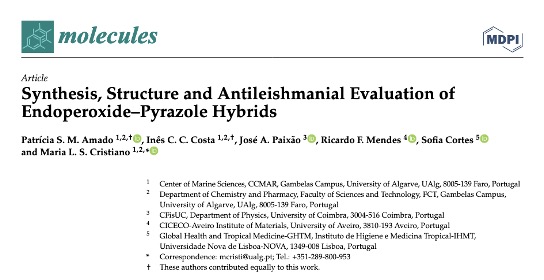Sofia Cortes, VBD-GHTM researcher, is co-author of the article about repurposing antimalarial drugs, recently published in Molecules as part of the Special Issue Recent Advances in the Synthesis and Biological Studies of Five-Membered Azaheterocycle Derivatives.
In view of previous studies in which selected 1,2,4-trioxanes, 1,2,4,5-tetraoxanes, and pyrazole-containing chemotypes showed activity against Leishmania parasites, this study reports the synthesis and structure of trioxolane–pyrazole (OZ1, OZ2) and tetraoxane–pyrazole (T1, T2) hybrids obtained from the reaction of 3(5)-aminopyrazole with endoperoxide-containing building blocks.
“Interestingly, only the endocyclic amine of 3(5)-aminopyrazole was found to act as a nucleophile for amide coupling”. However, “the fate of the reaction was influenced by the prototropic tautomerism of the pyrazole heterocycle, yielding 3- and 5-aminopyrazole containing hybrids that were characterised by different techniques, including X-ray crystallography”. The compounds were evaluated in vitro for they antileishmanial activity against promastigotes of L. tropica and L. infantum, and for cytotoxicity against THP-1 cells. Selected compounds were also investigated against intramacrophage amastigote forms of L. infantum.
According to the authors, “trioxolane–pyrazole hybrids OZ1 and OZ2 exhibited some activity against Leishmania promastigotes, while tetraoxane–pyrazole hybrids proved inactive, most likely due to solubility issues”. Eight salt forms, specifically tosylate, mesylate, and hydrochloride salts, were then prepared to improve the solubility of the corresponding peroxide hybrids and were uniformly tested. It is also mentioned that “biological evaluations in promastigotes showed that the compound OZ1•HCl was the most active against both strains of Leishmania”, a finding corroborated by the results obtained in assessments of the L. infantum amastigote susceptibility. “It is noteworthy that the salt forms of the endoperoxide–pyrazole hybrids displayed a broader spectrum of action, showing activity in both strains of Leishmania”.
In conclusion, the researchers highlighted that “our preliminary biological findings encourage further optimization of peroxide–pyrazole hybrids to identify a promising antileishmanial lead”.
To read the full study, click here.
